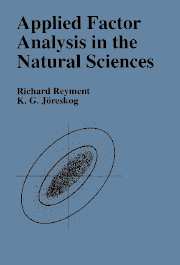Book contents
- Frontmatter
- Contents
- Preface
- Glossary of the most commonly used symbols
- Preface to first edition
- 1 Introduction
- 2 Basic Mathematical and Statistical Concepts
- 3 Aims, Ideas, and Models of Factor Analysis
- 4 R-Mode Methods
- 5 Q-Mode Methods
- 6 Q-R-Mode methods
- 7 Steps in the Analysis
- 8 Examples and Case Histories
- Appendix: Computer programs
- Bibliography
- Index
1 - Introduction
Published online by Cambridge University Press: 12 November 2009
- Frontmatter
- Contents
- Preface
- Glossary of the most commonly used symbols
- Preface to first edition
- 1 Introduction
- 2 Basic Mathematical and Statistical Concepts
- 3 Aims, Ideas, and Models of Factor Analysis
- 4 R-Mode Methods
- 5 Q-Mode Methods
- 6 Q-R-Mode methods
- 7 Steps in the Analysis
- 8 Examples and Case Histories
- Appendix: Computer programs
- Bibliography
- Index
Summary
STRUCTURE IN MULTIVARIATE DATA
Commonly, almost all natural scientists make a great number of measurements in their daily activities, for example, on the orientation of strata, geochemical determinations, mineral compositions, rock analyses, measurements on fossil specimens, properties of sediments, ecological factors, genetics, and many other kinds. You need only reflect on the routine work of a geological survey department in order that the truth of this statement may become apparent.
Scientific data are often multivariate. For example, in a rock analysis, determinations of several chemical elements are made on each rock specimen of a collection. You will all be familiar with the tables of chemical analyses that issue from studies in igneous petrology and analytical chemistry. Petrologists have devised many kinds of diagrams in their endeavor to identify significant groupings in these data lists. The triangular diagrams of petrology permit the relationships between three variables at a time to be displayed. Attempts at illustrating more highly multivariate relationships have led to the use of ratios of elements and plots on polygonal diagrams (cf. Aitchison, 1986).
Obviously, one can only go so far with the graphical analysis of a data table. The logical next step is to use some type of quantitative method for summarizing and analyzing the information hidden in a multivariate table. It is natural to enquire how the variables measured for a homogeneous sample are connected to each other and whether they occur in different combinations, deriving from various relationships in the population.
- Type
- Chapter
- Information
- Applied Factor Analysis in the Natural Sciences , pp. 1 - 14Publisher: Cambridge University PressPrint publication year: 1993



